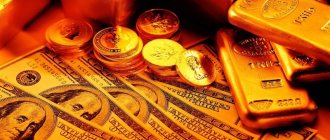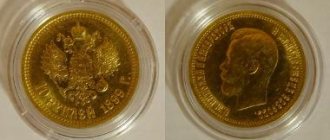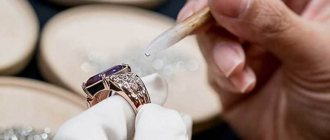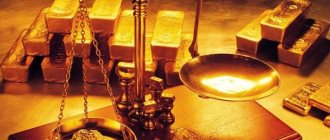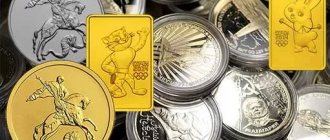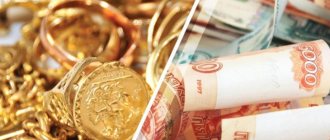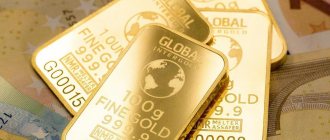Post updated: Jul 19, 2020
Currency is what rules the modern economy, along with other assets such as oil and precious metals. This is an invention that became significant for humanity and marked the beginning of a new era in trade relations. If in the Middle Ages the value of a coin was measured by its real component - metal, now paper money only denotes the benefits that lie behind it. Many of us are far from the financial sphere, but when making savings or getting involved in the trading system, it is worth finding out which currency is the most stable and backed by gold.
Educational program historical
A long time ago, people used a variety of objects, such as shells, as money. And also furs and animal skins. And also cocoa beans...
As a rule, money was used for items that, firstly, were valued among the local population, secondly, were relatively “mobile”, and thirdly, were relatively rare or, if not rare, then very useful in the household. Later, people paid attention to valuable metals and began making metal coins, which we still use today. Why did everyone choose gold and silver over animal skins?
Coins made from precious metals are highly valuable, easy to store, durable, and could be melted down into different items, even melted together or divided into smaller coins. Gold was considered to be resistant to counterfeiting because it could be identified by its softness (malleability), sound, color or weight. In general, it is not surprising that gold has become such a popular means of exchange.
Russian banks are breaking records for investments in gold. Is it time to follow their example?
Arguments of the parties
First blue argument "For"
Evolutionary: The modern financial system is divorced from the real economy.
The American dollar received the status of a convertible world currency after the signing of the Bretton Woods Agreement in 1944, with the aim of enhancing and simplifying interstate trade relations. of quotation was introduced and the exchange rates of world currencies were established relative to the American dollar - the monetary unit of a country whose economy did not suffer during the Second World War (however, as after the first, and even won during these wars).
In turn, the United States pledged to freely exchange dollars for gold from the Reserve Fund, that is, to back its currency with real gold reserves.
Exchange rates were fixed. Such a system could exist as long as the United States was able to exchange the dollar for gold. In 1949, the US reserve fund had 21,800 tons, which was 70% of the world's gold reserves at that time! But by the beginning of the 70s, the redistribution of the world's gold reserves in favor of Europe became noticeable. And the USA printed as many dollars as they wanted. By that time, there was already a significant, growing, unsecured supply of dollars in international circulation, and gold production volumes lagged significantly behind the growth of the world economy and, even more so, the growth of the money supply.
The current conditions have led to problems with the global liquidity of the dollar. In the spring of 1965, a French ship with a cargo of US dollars in the amount of 750 million tons anchored in the port of New York. According to the agreement, these banknotes were exchanged for 825 tons of gold at a rate of 1.1 grams. gold for $1. And this was not the last ship from France - by the end of this year, France had exchanged 4.92 billion US dollars for gold. Later Germany joined it.
In 1971 US President Nixon unilaterally abolished by his Decree the right to freely exchange paper dollars for gold. Essentially, violating the strategic global financial agreement. The world was silent. The year 1971 became the starting point from which the money supply lost its last connection with the real world.
First blue "Con" argument
Quixote: A fiat currency is actually quite backed.
Take, for example, the American dollar, which is not backed by gold or energy resources.
But it is supported by many other provisions, which at first glance do not seem obvious.
This is an advanced US economic system The most developed trade with the highest status in the world.
This is the world's foremost political and military power . The whole world is lining up to the sounds of the American anthem. No country in the world has such a number of military bases around the world, such firepower, or the ability to influence the internal politics of other countries.
The United States has a concentration of various resources and material assets with an estimated estimated value of $45 trillion, which constantly generate income.
Huge loans were issued in dollars . The banking system expects their return with interest. And this is very good security - waiting for your piece of the pie.
The low level of dollar inflation is an obvious fact.
Life itself confirms the stability of the dollar. And hence people’s faith in him. Trust, a habit of billions of people, mass consumption of the dollar.
For example, you can pay with a banknote from the early 20th century. Billions of people around the world trust the dollar and strive to keep their savings in dollars.
I have given a list of seemingly unobvious, but reinforced concrete guarantees for the dollar. But all other so-called fiat currencies are also tied to the dollar and have their own trailer of unobvious security. Therefore, fiat currencies are very much backed.
Second green argument “For”
Evolutionary: Money has turned from an equivalent of value into a commodity.
On March 16, 1973, at the Jamaica International Conference, exchange rates were subject to the laws of the market. From that moment on, they ceased to be fixed and began to change under the influence of supply and demand. Like sunflower seeds at the market - the more buyers, the more expensive the sunflower seeds. Money officially acquired the basic characteristics of a commodity, which marked the beginning of the rapid development of the speculative world financial system, the fruits of which we are already reaping and laid the foundation for all future world economic crises.
The paradoxical unreasonableness of assigning the properties of a commodity to money is that money, in essence, is the equivalent of material values and human labor. Thus, the exchange of money for goods or services is a natural process of money circulation. But buying money for other money is nothing more than an exchange of “equivalents”. This is only possible in conditions where the currency is clearly tied to the real economy and is backed by material values. Otherwise, the question arises: “Which state’s equivalent is more expensive? How long? And why is an hour of work by a citizen of one state more expensive than an hour of similar work on a similar product by a citizen of another state?”
It turns out that the welfare of citizens and the safety of their savings directly depends on the fact that today some slackers on the interbank market bought more of some currency, and less of some, and also made money on it. These insane, from the point of view of the real economy, processes determine the exchange rate in conditions of their free conversion. Thus, after the Jamaica Conference, the printing of world currencies began to be carried out according to the principle of a financial pyramid.
Second green argument "Con"
Quixote: A secured currency can only be supported by an unsecured one.
It has such fundamental disadvantages.
First of all, a return to the gold standard is technically impossible . Let's compare. For example, the size of world GDP increased sixfold between 1950 and 1995! And gold in bank reserves remained at 33 thousand tons. Today, the dollar supply reaches 2.6 trillion dollars, while the US gold reserve is only 260 million troy ounces, with its market value of about 431 billion dollars.
There is simply not enough gold in the world to meet the needs of the global economy.
By the way, why did economic crises occur frequently and frequently during the time of the gold standard, more often than with unsecured money? Life itself shows that secured money does not save you from crises. On the contrary, they aggravate them, because central banks are deprived of flexibility and are tied hand and foot by the inability to intervene in destructive economic processes.
Another thing is unsecured money. A crisis wave comes - you can turn on the printing press, adjust inflation, unemployment, interest rates on loans, and so on. Of course, there is also a side effect in the form of numerous financial bubbles. It turns out to be stagnation again, another crisis. Well, nothing, there is no good without a silver lining. Moreover, life itself shows that there is more good. Otherwise, why would we harm ourselves?
The third red argument "For"
Evolutionary: The liquidity of the world's reserve currencies lies in the realm of psychology, not economics.
So, from my first two arguments we can conclude that money has turned from an equivalent of value into a commodity for the speculative market. Banknotes are not backed by anything; moreover, they are being issued uncontrolled (printed).
Joseph Caillot, a former finance minister in one of Georges Clemenceau's cabinets, once told de Gaulle an anecdote:
A painting by Raphael was put up for sale at the Drouot auction in Paris. The Arab offered oil to purchase the masterpiece, the Russian offered gold, and the American, raising the price, laid out a pile of hundred-dollar bills for Raphael and purchased the masterpiece for 10 thousand dollars. “What’s the trick here?” - de Gaulle was surprised. “And the fact,” answered the ex-minister, “is that the American bought Raphael... for three dollars. The cost of the paper on which one hundred dollar bill is printed is only three cents.”
These processes are still ongoing.
The first audit in the history of the US Federal Reserve, conducted in 2012, showed that during and after the 2008 crisis, this private corporation secretly issued and distributed $16 trillion to “its” banks. Noteworthy is the fact that among the recipients of financing there are also foreign banks, which is strictly prohibited by American law. In fact, this is a violation of all the rules, and simply counterfeiting.
German economist Paul Fritz calculated that 26 times more money has been printed than can be purchased in goods, real estate and everything that is sold on the globe. Therefore, it is not surprising that plots on the Moon are already being sold.
This huge, unbacked money supply, which economists call “hot money,” is the main source of all the global crises that have shaken the world economy and which, apparently, will bury this economy. Thus, we are dealing with an economic and financial paradox when a reserve currency, which has not been backed by anything for almost half a century and is essentially just paper, retains its liquidity. Humanity, by inertia, perceives it as money, and this fact lies in the field of psychology, and not in the field of economics. That is, this is a global scam.
Third Red Argument Against
Quixote: The emergence of fiat currency is due to evolution.
This is, therefore, a reasonable given of the present moment.
Let's look into the past.
Before the advent of money, barter flourished. Then the first commodity money appeared - livestock, furs, animal skins, and so on. The next stage is the use of gold and silver as money, first in the form of bars and then in the form of coins.
The use of money made it possible to divide barter into two processes - the acquisition of goods and the sale of goods. Then the movement of money took shape as a separate independent process. As a result, it became possible to accumulate money and also lend it out.
Let's go further - instead of money that has its own value, paper money appeared, which essentially did not have its own value. This was already the first step towards issuing money without gold plating, but which can be printed, tied to the needs of circulation.
After paper money came electronic money. And now we are on the verge of the blossoming of cryptocurrencies, which are currently even more insecure than the previous so-called fiat money. By the way, let me remind you that fiat money is precisely our symbolic money, which has no independent value. The US dollar is fiat money. And the hryvnia too. And the euro.
So fiat (or otherwise unsecured) money is the trend of this century. Although in the first argument I sufficiently substantiated that they are even better secured than gold ones.
Fiat money is a requirement of the times, a specific feature of the development of civilization at this stage. Time demands that the nominal value of a currency should not be limited by resources.
So, I have summarized here the history of the development of money and shown how fiat money appeared completely naturally, in an evolutionary way, and therefore we can say with confidence that today’s currency should not be backed by gold or energy resources.
Why was gold exchanged for paper?
Gold is, of course, good, but, as it turned out, it also has its drawbacks. For example, you can cut small pieces from coins and then melt them together into something else. The gold in the cut coin will be less than “according to the declared value.” If the coins are lost, then a valuable medium of exchange will disappear from the economy (new gold coins are not easy to make). And, perhaps, the main problem is transporting coins over long distances. First of all, they are heavy. Very. Secondly, transporting gold itself is an unsafe task and, therefore, expensive.
Sergey Altyntsev, private investor, association of experts “Friend of Coins”:
— Gold is the metal of the Day of Judgment. You can use it to buy anything you want when and if the current financial system collapses due to the many accumulated problems.
What are banknotes
In fact, initially banknotes are, roughly speaking, “receipts” stating that a certain merchant left a lot of gold in a special institution and can be guaranteed to receive the same amount of gold in another branch of this institution. Why transport gold yourself along a trade route if you can hand it over in one place and receive it in another by presenting a paper receipt? Comfortable? And how!
So it turns out that the first banknotes appeared thanks to gold and were of no value without it. But what then?
Top 5 Cryptocurrencies Backed by Gold
Gold-backed cryptocurrencies are a recent innovation and many people are confused about which one they should invest in since there are so many of them.
Below are the five major gold-backed cryptocurrencies:
Perth Mint Gold (PMGT)
Perth Mint Gold token is one of the best gold-backed cryptocurrency tokens. It is backed by a real gold block from the Perth Mint in Western Australia.
PMGT is a good investment because the weight and purity of the gold is guaranteed by the Australian government
.
Through the GoldPass app, the Perth Mint issues digital gold certificates as proof of token security.
It is this certificate that supports the PMGT token at a 1:1 token to certificate ratio. PMGT is cost effective compared to a traditional gold asset. For example, there are no insurance or storage fees for bank transfers of gold and gold ETFs.
KuCoin is one of the trading platforms where you can buy PMGT tokens.
DigixGlobal (DGX)
DigixGlobal token has a value of 1g of gold per token
. DGX is provided by a Singapore company, but the vault where the token is stored is located in Singapore and Canada.
The storage facility is fully insured and Bullion accredited as an additional security measure.
With the DGX token, you can share, redeem and transfer real gold bars while buying and selling virtual gold in the form of tokens. This digitalization process was created by the founders of DigixGlobal to help normalize access to gold
.
To exchange your token for real gold, DigixGlobal charges a 1% fee. This is different from GoldPass, which is free. In addition, DigixGlobal is responsible for storage costs.
Gold Coin (GLC)
GLC is a fractional form of gold-backed cryptocurrency. This means that one coin is equivalent to a fraction of one gram of gold
.
GLC has a low barrier to entry, meaning that most people can afford to own gold by purchasing Gold Coin, unlike many gold-backed cryptocurrencies and real gold, which can be expensive to purchase.
GLC uses the Ethereum blockchain and is one of the most secure platforms
.
Tether Gold (XAUT)
The issuer of the Tether Gold token is also responsible for issuing the largest US dollar-backed stablecoin. Each Tether Gold token represents one ounce of gold
for one London bar. XAUT uses the Ethereum and Tron blockchain.
The Swiss Vault is where Tether stores its gold reserves. You can find the serial number of a specific gold bar on their website.
Meld Gold
Meld Gold is an Australian startup that is teaming up with Algrorand, a blockchain protocol, so they can develop a decentralized token
.
Through its massive digital platform, Meld Gold aims to further restructure the buying and selling of gold by combining it with the existing gold supply chain.
Through tokenization, the combination with the current supply of gold will allow them to quickly provide good trading and settlement. Through the platform, holders will be able to buy real gold and virtual tokens.
Some advantages of the platform are that it is efficient
, is highly available and transactions are completed quickly and easily.
What is the gold standard
The gold standard was first introduced in Great Britain in 1821. At that time, the pound sterling was considered to be “backed by gold”, people could freely convert paper money into coins and vice versa. Other countries took up this idea and printed their own banknotes backed by the precious metal.
Interesting fact: in Russia the gold standard was introduced quite late - in 1897. This event is also known as Witte's monetary reform.
In short, the gold standard is when you have money and you can exchange it for gold at any time (and you cannot be refused).
Who issues gold-backed coins?
Gold-backed cryptocurrencies are not produced by a single individual or company. Rather, they are produced by different organizations
. This allows potential investors to make their choice based on competitive market research.
For example, the Perth Month Gold token is backed by real gold from the Perth Mint in Western Australia, DigixGlobal is backed by a Singapore company, and other gold-backed cryptocurrencies are backed by other organizations.
Why is this standard needed at all?
Until now, many experts believe that the gold standard makes the economy more stable. The exchange rate of money in such conditions is tied to the rate of gold, and, frankly, they play a secondary role here - everyone is interested in the precious metal, and banknotes simply allow you to exchange it at a stable rate at any time. Economists in such cases delicately call the currency “reserve”.
By the way, in addition to the gold standard, there is also the term “silver standard”.
What would happen if the gold standard was abolished?
As history has shown, states can quite successfully print unbacked money. This requires a monopoly on the issuance of the currency—making that currency the only legal medium of exchange.
True, if you abolish the gold standard and declare to everyone that money is valuable in itself, it turns out that its “value” in the free market is very dynamic. “Unsecured” money has high volatility, and can also be “reprinted” at any time, which will lead to inflation.
Conclusion
It is even more fair to have a cryptocurrency backed by gold than a cryptocurrency backed by dollars because if a cryptocurrency is not backed by any underlying asset, how is that different from a stablecoin backed by US dollars, which in turn are not backed by any physical asset ?
However, given the nature of blockchain technology, they have many opportunities in the area of asset-backed currencies.
When using a gold-backed cryptocurrency, there is a possibility that it will open the door to cryptocurrency tokens that will be backed by copper, gold or nickel in the future.
What is the gold standard?
- Gold coin - originated in countries where they paid with gold coins and everyone could exchange banknotes for coins at the rate indicated on the banknote.
- Gold bullion - appeared later (for example, in France - at the beginning of the twentieth century). Money can still be exchanged for gold, but now only for bars. The cost of one gold bar is usually so high that most people are simply unable to exchange their paper savings. However, formally the security of money remains.
- Gold and currency - appeared after the Bretton Woods conference in 1944. At that time, the United States backed its national currency with gold at a rate of $35 per troy ounce. True, in 1971 the country abandoned the exchange of currency for the precious metal, and the era of the gold standard came to an end. Or not?
Leading currencies
Let's look at the strongest world currencies. The franc is a reliable currency, as Switzerland is the world's largest banker and its gold reserves cover the currency by about 40%. Stability encourages people to use this currency. The euro is a strong currency introduced throughout the EU; it is a reserve currency and ranks second in the foreign exchange market after the dollar. Despite crises, the abundance of gold reserves and influence on many industries and markets make the euro one of the priority currencies.
The Japanese yen also plays an important role, especially in Asia. It is sufficiently backed up with gold to not cause concern, but may fluctuate during cataclysms or other incidents. The New Zealand dollar is an active participant in trading, but is a fairly rare currency outside the country. It is stable, since the country’s GDP is growing steadily, the country has few debts, and there are minimal reasons that would prevent its currency from growing.

